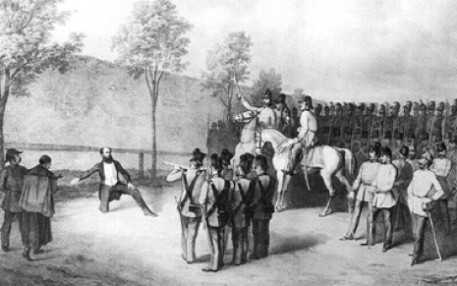The Execution of Lajos Batthyány and the Martyrs of Arad – 6th October 1849
Szöveg: hungariandefence.com | 2011. október 6. 6:43Lajos Batthyány, the Prime Minister of the first responsible Hungarian government and the 13 martyrs of Arad were executed 162 years ago, on 6th October 1849. We commemorate the historic event by excerpting from the book “For the Homeland Unto Death – 1100 Years” published by Zrínyi Média, which is available in our Digital Library.

was followed by military invasion
and bloody reprisals. The judgement
of the Emperor and his government was implemented
by Field Marshal Haynau, who
bragged, “I will hang the rebel leaders," “I will
have the turncoat officers shot," “I will pull up
the weeds by their roots, I will set an example
to all of Europe as to how rebels are to be dealt
with and how to ensure order, calm and peace
for a century."
The executions followed one after
another throughout the dark autumn of 1849.
On 6 October, the Prime Minister of the first
Hungarian government, Count Lajos Batthyány,
was shot in Pest, and the same day twelve heroic
generals and a colonel were executed in Arad.
The names of Lajos Aulich, János Damjanich,
Arisztid Dessewffy, Ernő Kiss, Károly Knézich,
György Lahner, Vilmos Lázár, Károly Leiningen-
Westerburg, József Nagysándor, Ernő Pöltenberg,
József Schweidel, Ignác Török and Károly
Vécsey stand as a memorial and a sign that Hungarians,
Germans and Serbs fought and died side
by side, for liberty!
After the executions, retribution continued
with fearsome sentences by the thousand: captivity
in heavy irons, damp dungeons and hard
labour, confiscation of property and punitive
military service. The blind thirst for retribution
exceeded the limit of any inclination to make
peace. If the war made heroes, the reprisals made
martyrs, and the nation should never forget them.

was again detached, new crown provinces
were set up under the names of Serbian Voivodina
and Temes Banat; the remainder of the country
was divided into five districts administered first
by soldiers and later by district bailiffs, beneath
them “county prefects". The Emperor’s uncle,
Archduke Albrecht, was appointed at the head
of the occupied and annexed country. The real
power was held by the Minister of the Interior
in Vienna, Alexander Bach. An army of his administrators,
the “Bach Hussars" flooded the
country.
Hungary in defeat was “pacified" by military
occupation and total absorption – political,
administrative and economic – into the
Habsburg Empire. This was designed as a punishment
for the country having abused its
constitutional rights by “rebellion". Hungary
was not alone in being dealt with in this way;
all the peoples of the Empire were treated similarly.
The bitter spirit of the age was that
nationalities loyal to the dynasty received in
reward the same as the Hungarians did in punishment:
raw tyranny and injustice. The only
one of the 1848 reforms recognised under
absolutism was the freeing of the villein peasants;
equality under the law, and all other right and
institution of constitutionality and liberty, were
repealed. The national autonomy promised in
the 1849 Olomouc Constitution was left to rest
on paper. In fact the constitution itself was soon
dropped, and on the last day of 1851, unlimited
imperial absolutism was proclaimed.